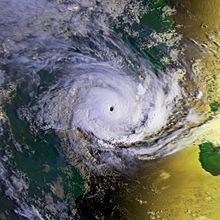
Back بوابة:بوتسوانا Arabic Portal:Botsuana Spanish Portail:Botswana French Portal:Botswana Portuguese Портал:Ботсвана Russian Портал:Ботсвана Ukrainian باب:بوٹسوانا Urdu
Intro
Botswana, officially the Republic of Botswana, is a landlocked country in Southern Africa. Botswana is topographically flat, with approximately 70 percent of its territory part of the Kalahari Desert. It is bordered by South Africa to the south and southeast, Namibia to the west and north, Zambia to the north and Zimbabwe to the northeast. With a population of slightly over 2.4 million people and a comparable land area to France, Botswana is one of the most sparsely populated countries in the world. It is essentially the nation-state of the Tswana people, who constitute nearly 80 percent of the population. The Tswana ethnic group are descended mainly from Bantu-speaking peoples who migrated into southern Africa, including modern Botswana, in several waves before AD 600. In 1885, the British colonised the area and declared a protectorate named Bechuanaland. As part of the decolonisation of Africa, Bechuanaland became an independent Commonwealth republic under its current name on 30 September 1966. Since then, it has been a parliamentary republic with a consistent record of uninterrupted democratic elections, although the Botswana Democratic Party was the only ruling party from independence until 2024. As of 2024[update], Botswana is the third-least corrupt country in Africa, according to the Corruption Perceptions Index published by Transparency International. The economy is dominated by mining and tourism. Botswana has a per capita GDP (purchasing power parity) of about $20,158 as of 2024[update]. Botswana is the world's biggest diamond-producing country. Its relatively high gross national income per capita (by some estimates the fourth-largest in Africa) gives the country a relatively high standard of living and the second-highest Human Development Index of continental Sub-Saharan Africa (after South Africa). Despite this, Botswana continues to grapple with high unemployment rates. Botswana is a member of the Southern African Customs Union, the Southern African Development Community, the Commonwealth of Nations and the United Nations. (Full article...)
Selected article - The Presidential Commission of Inquiry into Land Problems in Mogoditshane and Other Peri-Urban Villages, also known as the Kgabo Commission, was a 1991 commission of inquiry established by the government of Botswana. It was created to investigate allegations that illegal sale and purchase of land was taking place in peri-urban villages such as Mogoditshane without the authorisation of land boards. Englishman Kgabo was appointed as its chairman. It published its findings and recommendations in the Kgabo Report, which found that due to housing shortages and a failure of the land board system, most land sales in Mogoditshane were unauthorised. The commission caused a major political scandal when it implicated Vice-President Peter Mmusi and Minister of Agriculture Daniel Kwelagobe, both of whom held leadership positions in the dominant Botswana Democratic Party (BDP). They resigned from their positions, but the party reelected them as party leaders in the subsequent congress. The accusations against Mmusi and Kwelagobe were declared void by the High Court of Botswana because they were not granted a hearing to defend themselves. The scandal prompted two factions to form within the party, those who supported Mmusi and Kwelagobe and those who opposed them, and these factions dominated politics in Botswana for the next two decades. (Full article...) Did you know - ... that in Botswana, writer Unity Dow (pictured) took legal actions as a plaintiff, legal counsellor, and judge to challenge gender discrimination and protect indigenous rights, before becoming a legislator? This is a good article, A-class article, featured list, or featured article, one of Wikipedia’s best work.
Intense Tropical Cyclone Leon–Eline was the second longest-lived cyclone in the Indian Ocean, behind Cyclone Freddy, traveling over 11,000 km (6,800 mi) during its 29-day track through the Indian Ocean, throughout the month of February. The cyclone formed on 1 February 2000, in the Australian basin as Tropical Cyclone Leon, and was renamed Eline after crossing 90° E into the South-West Indian Ocean; there, the Météo-France office in Réunion (MFR) tracked the storm's movement and intensity. Late on 17 February, Eline made landfall near Mahanoro, Madagascar, with 10‑minute winds of 165 km/h (103 mph). The storm rapidly weakened over land, but restrengthened in the Mozambique Channel to reach peak 10‑minute winds of 185 km/h (115 mph), making it an intense tropical cyclone. On 22 February, Eline made landfall about 80 km (50 mi) south of Beira, Mozambique, near peak intensity. Eline quickly weakened over land as it moved across Southern Africa, finally dissipating over eastern Namibia on 29 February. While moving across much of the Indian Ocean, Eline brought high waves, gusty winds, and rainfall to several islands. When Eline struck Madagascar, the country was in the midst of a cholera epidemic that killed over 1,000 people. Eline directly killed at least 64 people in the country. Tropical Storm Gloria struck Madagascar 13 days later, compounding the damage and making it difficult to discern the individual effects. Damage from Eline was estimated at $9 million (USD), and collectively the two storms killed 205 people and left another 10,000 homeless. In the region around Vatomandry where Eline made landfall, 65% of houses were damaged, 90% of crops were lost, and 75% of health facilities were wrecked. (Full article...) General images -The following are images from various Botswana-related articles on Wikipedia.
Related portalsOther South African countriesReligion in BotswanaBotswana-related articlesCategoriesAssociated WikimediaThe following Wikimedia Foundation sister projects provide more on this subject:
| |||||||||||||||||












































































